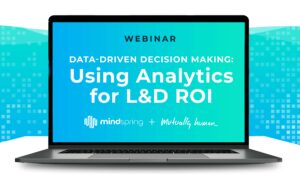
As organizations strive to enhance their learning experiences, strategies, and technologies, the need for precise, actionable metrics to gauge success has never been more critical. In “Benchmarking Success: Metrics that Matter in Learning Analytics,” we explore the essential metrics in learning analytics that can benchmark success and drive continuous improvement in your learning programs.
Understanding Learning Analytics
Learning analytics involves the collection, measurement, analysis, and reporting of data about learners and their contexts. This data is used to understand and optimize learning and the environments in which it occurs. By leveraging learning analytics, organizations can gain insights into learner behavior, engagement, and outcomes, thereby making informed decisions to enhance learning experiences and strategies.
Key Metrics in Learning Analytics
Completion Rates
Completion rates indicate the percentage of learners who finish a course or training program. High completion rates often signify that the content is engaging and relevant. However, it is essential to analyze these rates in conjunction with other metrics to ensure learners are not merely completing courses without truly understanding the material.
Engagement Levels
Engagement metrics, like Level of Engagement (LoE), track how actively learners interact with the content. This includes metrics such as time spent on activities, participation in discussions, and frequency of logins. High engagement levels typically correlate with better retention and application of knowledge.
Assessment Scores
Assessment scores provide direct feedback on learner comprehension and retention of the material. These scores can be gathered from quizzes, tests, assignments, and practical evaluations. Consistently high scores indicate effective learning, while low scores may highlight areas where the content or delivery method needs improvement.
Learner Satisfaction
Learner satisfaction is typically measured through surveys and feedback forms. It provides qualitative data on learners’ perceptions of the course’s relevance, difficulty, and overall experience. High satisfaction rates can boost motivation and commitment, while low rates can indicate issues that need addressing.
Knowledge Retention
Knowledge retention metrics evaluate how well learners retain information over time. This can be assessed through follow-up quizzes or practical assessments weeks or months after the initial training. High retention rates suggest that the training methods and content are effective and impactful.
Behavioral Changes
One of the ultimate goals of learning programs is to drive behavioral changes that improve performance. Metrics such as the application of new skills on the job, changes in productivity, and improvements in work quality can provide evidence of successful training. These changes are often tracked through performance reviews and manager feedback.
ROI (Return on Investment)
ROI measures the financial return on the investment made in training programs. This includes calculating the benefits gained (e.g., increased productivity, reduced error rates) against the costs incurred (e.g., development, delivery, and maintenance of training). A positive ROI indicates that the training program is delivering tangible value to the organization.
Learning Pathways
Learning pathways metrics track the progression of learners through various stages of their training. This includes monitoring the courses completed, certifications achieved, and milestones reached. These metrics help in understanding the learning journey and identifying potential bottlenecks or drop-off points.
Implementing Effective Learning Analytics
To effectively implement learning analytics, organizations need a strategic approach:
- Define Clear Objectives
Establish what you aim to achieve with your learning programs. Clear objectives help in selecting the right metrics and aligning them with business goals. - Choose the Right Tools
Invest in robust Learning Management Systems (LMS) and analytics tools that can collect, analyze, and report the necessary data. These tools should integrate seamlessly with other systems to provide a holistic view of learning and performance. - Data Integration
Combine data from multiple sources such as LMS, HR systems, and performance management tools. Integrated data provides a comprehensive view of learning impact and helps in making more informed decisions. - Regular Monitoring and Reporting
Continuously monitor the selected metrics and generate regular reports to track progress. Use dashboards and visualizations to make data easily interpretable and actionable for stakeholders. - Feedback Loops
Create mechanisms for continuous feedback from learners and instructors. This feedback should be analyzed and used to refine and improve learning programs continuously. - Actionable Insights
Translate data into actionable insights. Instead of just collecting data, focus on how the insights derived can inform decisions and drive improvements in learning experiences and outcomes
The Future of Learning Analytics
As technology advances, the future of learning analytics will see increased integration of artificial intelligence (AI) and machine learning (ML). These technologies can provide deeper insights through predictive analytics, identifying at-risk learners and suggesting personalized learning paths. Additionally, the use of big data will enable more precise tracking of learning behaviors and outcomes, allowing for highly customized and effective learning experiences.
Benchmarking success in learning analytics involves understanding and utilizing the right metrics to measure and improve learning programs. By focusing on completion rates, engagement levels, assessment scores, learner satisfaction, knowledge retention, behavioral changes, ROI, and learning pathways, organizations can create a data-driven approach to learning and development. This approach not only enhances the learning experience but also drives organizational growth and success. As we move forward, the integration of advanced technologies will further revolutionize how we measure and optimize learning, ensuring that training programs are both effective and impactful.
Looking for more resources on learning metrics and ROI?

Data-Driven Decision Making: Using Analytics for L&D ROI
Are you looking to connect learning performance with business outcomes? Not sure how to use data to make decisions about your learning engagements? The task of measuring the impact of your learning investments is often challenging, especially with the perception that data might not be readily available—but that’s not necessarily true.

The Learning ScoreCard: How To Measure L&D Impact And Prove ROI
How does a learning and development team make their return on investment both measurable and visible? This eBook introduces a system to track the right metrics using the right methodology to visually display and quantify the investment in learning and prove ROI.


